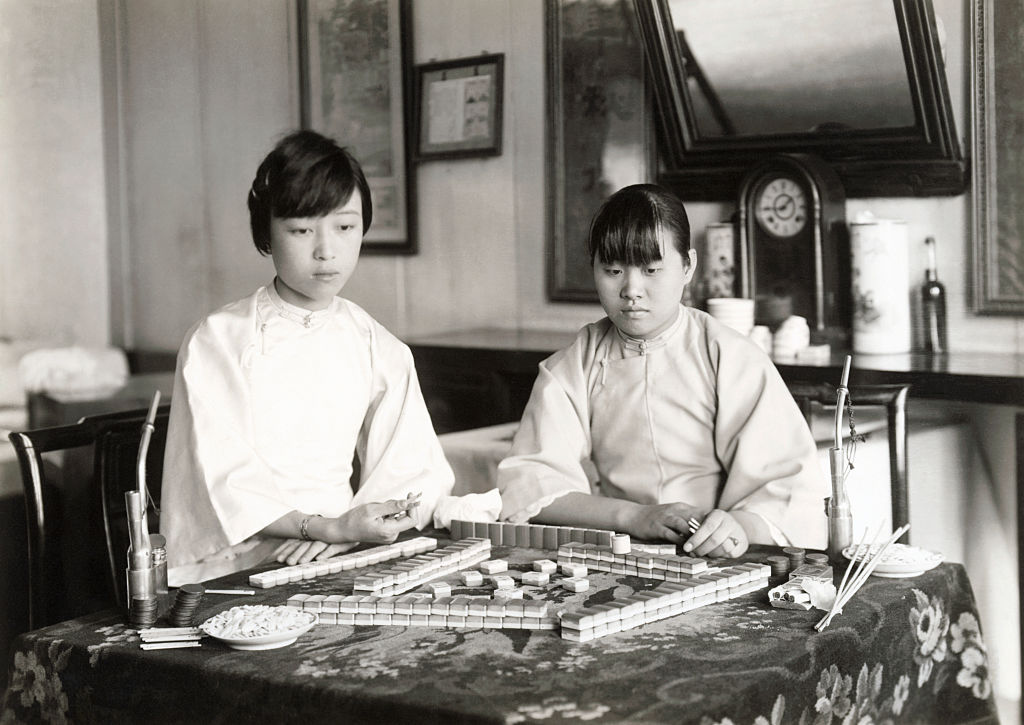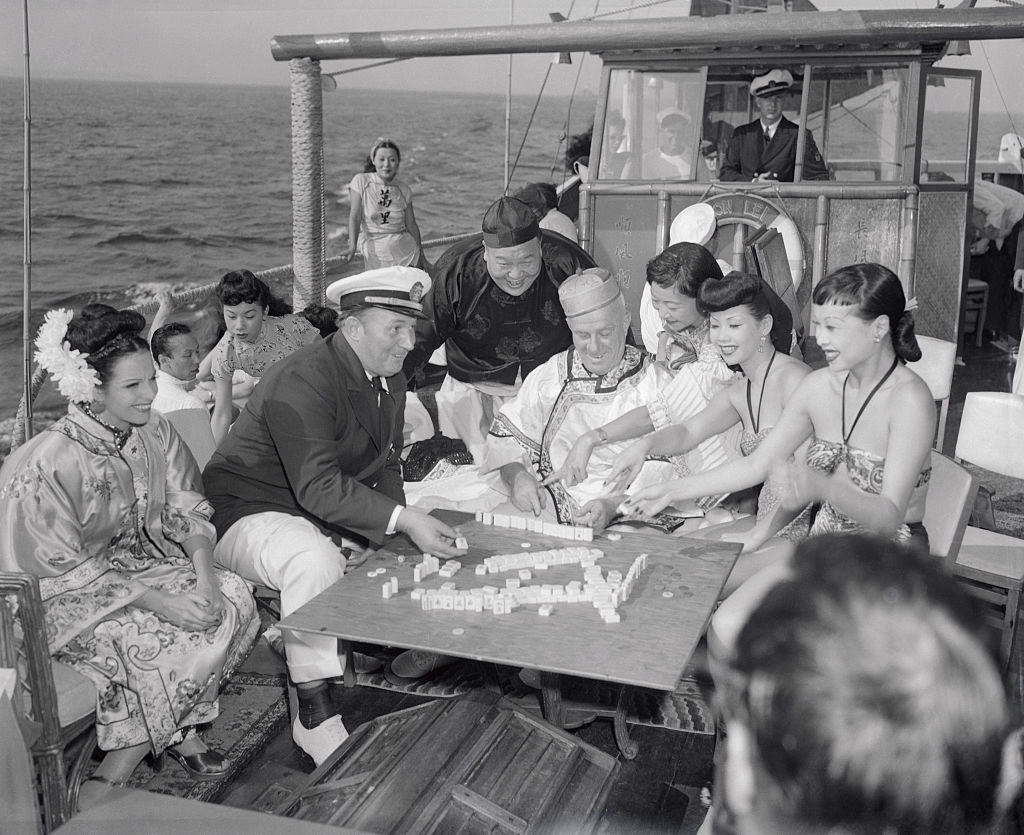
Mah-jongg, a game in which players match or sequence sets of tiles, is often referred to as China’s “national pastime.” However, its rise as a globally beloved game has roots somewhere else: in the emergence of modern American culture in the 1920s.
This surprising history is explored in depth in Annelise Heinz’s new book, Mahjong: A Chinese Game and the Making of Modern American Culture, in which she makes the case that the game—the name of which has multiple accepted spellings—can provide valuable insight into how factors of identity like race, gender, ethnicity and sexuality evolved and intersected in a swiftly changing world. Heinz maps out how, across cultures and countries, from its origins in China in the 1800s to its revived popularity among Jewish American women in the 1950s, mah-jongg has always been a way to find community.
This throughline of connection is one that also spans generations and groups. As a young Chinese American girl growing up in the Bay Area, I played mah-jongg as a way to bond with my grandparents. Now, after moving to Brooklyn as an adult, playing mah-jongg at a local Asian grocery store has become a weekly fixture on my social calendar, as friends who learned how to play American-style with their bubbes shuffle tiles alongside new friends from the neighborhood who are playing for the first time.
The long and diverse history of the game has had its fair share of controversies, however, especially when it comes to race—a recent critique of a company’s “refresh” of the game as possible cultural appropriation earlier this year uncannily echoed concerns raised during the height of the game’s popularity in the early 20th century.
“Mah-jongg has the power to be both a bridge and a barrier,” Heinz told TIME in a phone interview. “I hope that we can learn from the past to also embrace the positive, wonderful possibilities of this great game that so many people love around the world, and that has brought so many people together.”
Ahead of the book’s release this week, Heinz spoke with TIME about the history of mah-jongg, its role in modern American culture and how the game became a way for a diverse range of groups to find community.
Get your history fix in one place: sign up for the weekly TIME History newsletter
What initially piqued your interest in mah-jongg as a game, and then as the focus of your work as an academic?
I lived for a year in southwestern China, before beginning my Ph.D. program. And when I was there, I saw mah-jongg everywhere. It was just really a part of the fabric of public life as well as private life. But it was really my aunt, who had grown up in a strongly Jewish part of Denver in the 1950s and ‘60s, who asked the question, “Why do all my Jewish friends play mah-jongg?” that started my interest in exploring the history of the game, and particularly the history of the game in the United States. What I found is that a lot of people have asked the question, and there was a lot of misinformation, a lot of theories, but no one had done the scholarly work to find out. In doing my initial research, I found hundreds of newspaper articles talking about this massive national fad in the 1920s, in language that touches on gender, race, ethnicity and sexuality and I immediately knew this was a much bigger story. This tells us a lot about the making of modern American culture.
So, what are the origins of mah-jongg?
Mah-jongg was a relatively modern game that was developed in the mid-to-late 1800s, around the Yangtze River Delta. By the end of the 1800s, it was spreading in popularity in China, but mostly only in specific urban centers like Shanghai and Beijing. But in the early 1920s, it developed this international reputation, which helped spread interest in China as well. This trend was driven by exporters, marketers and businessmen, particularly Joseph Park Babcock, whose mah-jongg sales company helped popularize it with American expatriates living in China before intentionally marketing it as this new, exotic and cosmopolitan consumer good to the broader American public.
How did it become such an influential part of American gaming and culture?
When the fad began, it was a game associated with the American elite, people like President and First Lady Harding and Hollywood celebrities. But it soon became played by and talked about everywhere across the country. The game becomes a way for people, but especially white Americans, to help themselves transition into this new self-consciously modern era, because of its association with connection with Asia. There’s also this performative culture around mah-jongg; white women dress up in costumes to play the game in their homes, with their friends. For these white women, it meant that even respectable middle class or wealthy matrons, not just flappers, could inhabit these new boundaries of increasingly sexualized culture and femininity, which speaks to the ways in which gender and race are intertwined and the long history of how ideas of Asian people and Asian culture have taken form.

Can you speak more about how mah-jongg showed the changing intersections of race and gender during this time?
One way to see this particularly clearly is in how the game becomes associated with women during the 1920s. In its origins, Chinese mah-jongg was a mostly but not exclusively, male gambling game. In its initial years in the U.S., it was marketed by white men and written about by bridge experts who were predominantly white men. In other words, there was nothing about the initial introduction that would have indicated that it would become a game really strongly associated with femininity and with women within a few years. That happens rapidly, and it happens in the United States because American ideas of Asian culture were associated with non-normative gender and sexuality, and particularly a kind of broad feminization of Asian people and culture. So to have a game be so enthusiastically, emphatically emphasized as a Chinese game as part of its marketing, you can see the increasing distancing from white masculinity associated with the game. The portrayal and commodification of Chinese American femininity was broadly dovetailing with this commodification and exoticism surrounding this game.
What does this mean for Chinese Americans, most of whom were also introduced to the game at this time?
The dark cultural irony is that the 1920s were a very racist era; it’s a time of anti-immigrant sentiment. In 1924, the Johnson Reed Act further cements anti-Asian immigration restrictions and exclusions; it’s also the peak of the Ku Klux Klan in mainstream American culture. The game was gaining popularity because it was being marketed explicitly as an ancient royal Chinese game that was divorced from contemporary Chinese and Chinese American people. So it enabled white Americans to embrace a game they saw as an esteemed and elite part of a past Chinese culture, while rejecting Chinese people.
Chinese Americans were having their own experiences with the game and the broader fad and representation. Chinese Americans speak out against some of the really clear appropriation of the game that happens at various points. They also look for opportunities to make money in a really discriminatory economy in which Chinese American college graduates in English and art and engineering could not get jobs outside of curio shops and restaurants and laundry work, the same stereotyped and segregated economic sectors. And for a brief period of time, teaching people how to play mah-jongg actually provided a more lucrative opportunity, in part because they are seen as these authentic teachers, even if they actually just learned the game, from the same instruction manuals that are being circulated to white Americans as part of this whole complex, complicated economic landscape of orientalist consumerism. After the fad years died out, pockets of players continue playing the game and Chinese Americans continue playing the game. The meaning of the game for Chinese Americans is linked to community building. It’s linked to specific ways that generations can connect to each other across really significant generational divides in the 1920s and ‘30s. And it’s linked to looking also toward a link across the Pacific. Mah-jongg becomes one of many ways that Chinese Americans build a transnational nationalism.
How did American mah-jongg emerge and how did it become a part of the American Jewish tradition?
In the late 1930s, a group of Jewish women, including one named Dorothy Meyerson (who had already been marketing her own slightly adapted version of the game, which she called a streamlined version) decided to standardize the game and simplify some of the complicated scoring rules that had already been simplified from the original version. They met in New York City and formed the National Mah-jongg League in 1937. It was never intended to create a form of the game that would be primarily associated with Jewish women, but it spread along Jewish women’s networks and in ways connected to specific landscapes of leisure that Jewish Americans forged especially after WWII, most influentially in the Catskills. It served a really important and unusual kind of role in 1950s, rapidly suburbanizing, rapidly upwardly mobile, middle-class households, where Jewish Americans were able to access the middle class in a new generationally shifting way because of the larger context of the time. Women who are disproportionately highly educated and having participated in and leaving the workforce, are sharing this experience of young motherhood with other women in the suburbs. It becomes a norm once a week across households. It becomes this really powerful social thread and ends up becoming an ethnic marker as well.
Why do you think mah-jongg has helped to build community for a diverse range of groups, particularly in the U.S.?
This extends far outside of American culture, but part of why I think the game has fostered various and rich game cultures around the world is the rhythm of the game itself. In between each round, you have a pause, where you are shuffling the tiles, or “washing” the tiles. And it’s just the right amount of time to have a little bit of conversation. I think that tempo is perfect for building new relationships. When you’re in a new community or connecting across a generational divide, maybe you don’t want to have deep heart-to-heart or can’t have one, but you can have a little bit of conversation and over time, those rhythms, especially if you’re playing with the same group of people, can build incredibly deep, long-lasting relationships.
More Must-Reads from TIME
- How Donald Trump Won
- The Best Inventions of 2024
- Why Sleep Is the Key to Living Longer
- How to Break 8 Toxic Communication Habits
- Nicola Coughlan Bet on Herself—And Won
- What It’s Like to Have Long COVID As a Kid
- 22 Essential Works of Indigenous Cinema
- Meet TIME's Newest Class of Next Generation Leaders
Write to Cady Lang at cady.lang@timemagazine.com